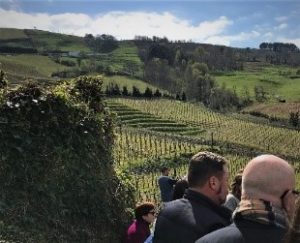The first mention of Txakoli (pronounced cha-ko-lee) wines dates back to 1520. The wine was locally consumed and rarely enjoyed beyond Basque Country borders. Historically, home-made in baserris (Basque farm houses), it was considered low-quality wine, and frequently used as barter between neighbors. It was fermented in old oak barrels and carried with it a reputation for going straight to the head, leaving behind serious headaches (cabezon).
Txakoli slowly disappeared until the second half of the 19th (1989) when, thanks to a group of tzakoli lovers, some varieties received the designation of origin certification (Denominacion de Origen or D.O. in Spanish). This took txakoli off life-support and started the process that improved quality. Today txakoli is a very pleasant wine, especially during the spring and summer. It is currently popular in the pintxos bars of San Sebastian, Spain and slowly, slowly becoming popular in other European cities… even finding a pathway into wine shops and restaurants in the USA.
Noted for its light sparkle and baby bubbles, this delicious, refreshing, food-friendly wine brings with it a refreshing, sprightly, puckering acidity, accentuated by the taste fresh lemons, apples and herbs.
Getaria


Txakoli wines are produced in Getaria, a subregion of the Spanish Basque country. One of the most popular bodegas in the area is Gaintza, with vineyards located on bluffs overlooking the bay in Guipuzcoa. Gaintz (on the top) refers to the location of the winery that was built in 1923 and has the largest collection of vineyards that produce txakoli and includes the Getariako designation of origin. READ THE FULL ARTICLE AT WINES.TRAVEL.
Dr. Elinor Garely. Editor-in-Chief, Wines.Travel and TourismExecutives.com; Reporter, eturbonews.com and etn.travel
•Expert Witness: Hospitality, Travel /Tourism industry with TASA Technical Advisory Services for Attorneys
•Award winning international journalist/consultant
Former Professor of Management/Marketing; Coordinator - Hotel, Travel /Tourism program - CUNY, BMCC
•Former Professor - Business Management /Marketing faculty - Long Island University, NYU Stern School of Business, University of Shanghai, PRC
•International marketing and management executive with Playboy Clubs and Hotels, the Copacabana and related restaurants/ clubs; Helmsley Spear (Hospitality Consultant Division), Babcock and Wilcox
•Developed/implemented first hotel joint venture in Russia; first hotel/restaurant management program at University of Shanghai, PRC; designed/ implemented hotel management training programs for hotels in the United States, China (PRC), Malaysia and Caribbean
•Received Ford Foundation grant to study role of Community Colleges in PRC; consultant to the government of Kenya to explore new economic development opportunities in the USA
•Research includes an analysis of Guest Safety/Security at 5-Star/Luxury Hotels in Bangkok, Thailand, Cape Town, South Africa and Miami, Florida (Dissertation); Child Trafficking; eMarketing and We Know What Women Want in Hotels
•Former Real Estate Sales/Broker: Hotel Industry
•Doctorate in International Business from the University of Sarasota (Florida): focus on hotel, travel and tourism and guest safety/security
•MBA in International Marketing and Business Management from New York University, Stern School of Business with Honors from the American Marketing Association; Former Member of BGS Honor Society
• BS Degree, Lesley College, Art / Education
•Former Member - BOD, Sutton Area Community organization, International Food Wine & Travel Writers Association and HSMAI. Current Member - NY Travel Writers Association, Princeton Club of New York



